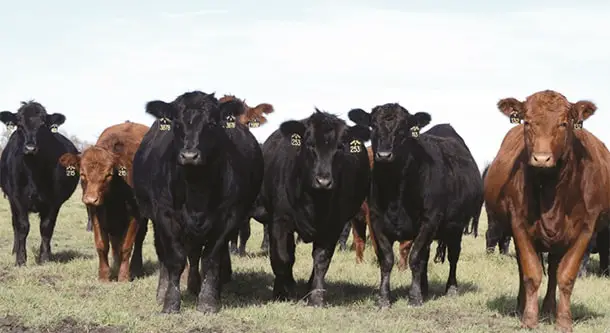Bovine Ephemeral Fever (BEF) is an arthropod transmitted viral disease of cattle and buffalo. The disease is characterized by fever, muscular shivering, stiffness, lameness, and enlargement of peripheral lymph nodes followed by spontaneous recovery after three days. The disease is also known as ‘three days sickness,’ bovine epizootic fever, and stiffsiekte.
Important Information on Bovine Ephemeral Fever
Very few animals die due to Bovine Ephemeral fever; instead, it has tremendous disruptive effects on production and animal husbandry. Calves that age is less than six months of age are least affected and show no clinical signs. Adult cattle and buffalos are worst affected, with morbidity rates up to 80-90% and almost no mortality. It spreads primarily through blood-sucking flies and mosquitoes, but blood transfusion also spread the disease. BEF occurs mainly in hot and humid summer when the mosquito population is high.

Causes of Bovine Ephemeral Fever
The BEF is a viral disease and is caused by the Ephemeral fever virus under the family Rhabdoviridae. The virus is a single-stranded RNA virus and having either sensitivity with five structural proteins. The virus is antigenically related to at least three other viruses non-pathogenic for cattle, like Kimberly virus, Berrimah virus, and Adelaide river virus.

Epidemiology of BEF
Bovine Ephemeral fever was first described in South Africa in 1906. The disease was known to have occurred previously and was referred to briefly by Schweinfurth in 1867. It was recognized in Egypt in 1895 and 1924. The disease is now known to exist in a broad belt to tropical, subtropical, and temperate countries in Africa, Asia, and Australia. It is the same disease as Bovine Epizootic fever in Japan.

The countries where BEFoccurs on both sides of the equator include all the counties of Africa and those of Asia South of the general line encompassing Palestine, Syria, Iraq, Iran, Pakistan, India, Bangladesh, China, and Southern Japan through Southeast Asia and Australia. There is serological evidence to support the BEF virus’s absence from Papua New Guinea, the Pacific Islands, the USA, and New Zealand. There has been no report of Ephemeral Fever from Europe or North or South America.
Transmission of BEF Virus
The epidemiological evidence indicates that the BEF virus is spread in nature only by an insect bite. The virus is isolated from infected cattle by inoculation of mosquitoes, and the virus has been recovered from some Culicoides and mosquito species collected from the field. The virus can be transmitted experimentally from infected to susceptible cattle by IV injection, and as little as 0.005 ml of blood collected during the febrile condition of the affected animal.

Transmission of the virus by contact or fomites does not occur, and the virus does not appear to persist in recovered cattle. It occurs in the summer in the temperate climate and is associated with recent rainfall. The BEF virus has been isolated from Culicine and Anopheline mosquitoes in Australia and from biting midges of the genus Culicoides in Africa and Australia.
Pathogenesis of Bovine Ephemeral Fever
The pathogenesis of BEF is as follows:
- The virus enters the crop of mosquitoes by sucking blood from the affected animal.
- The virus multiplies for an unknown period in the arthropod’s body and eventually reaches the salivary glands.
- At this time, the vector takes a second blood meal; the virus is transferred to the wound with the saliva.
- After entering into circulation, viruses localize and replicate in the mesodermal tissues of the muscles and joints and occur mainly in WBC in the bloodstream or joint transudates, in alveolar macrophages, and some visceral organs.
- The virus is thought to also replicate in the reticuloendothelial cells in the lungs, spleen, and lymph nodes and not in the vascular endothelium or lymphoid cells.
- The incubation period of the disease is 2-10 days.
- In natural cases, viremia (virus in the blood) usually persists 1-2 days and in experimental cases 3 days generally with fever.
- The peak of viremia is at least 24 hours before the neutrophil or temperature rise.

Clinical Signs and Symptoms of BEF
The starting of clinical signs and symptoms is usually rapid. The bulls, fatty cows, and bullocks are tended to be worst affected, with calves usually only mildly affected. The clinical signs include:
- Sudden onset of fever (105 -106° F), which is biphasic.
- Anorexia.
- The sudden drop in milk production.
- Neutrophilia, lymphopenia, and increase of plasma fibrinogen.
- Depression.
- Muscle Stiffness or lameness.
- Decrease plasma calcium and zinc levels.
- Shivering.
- Nasal and ocular discharges.
- Edema affecting around joints and subcutaneous emphysema.
- Fever and lameness usually decrease after 3 or 4 days, so the disease is called three days sickness.

Diagnosis of Bovine Ephemeral Fever
- A presumptive diagnosis of BEF is made by history of the enzootic area and clinical findings.
- The confirmatory diagnosis is made by detection of antigen and antibody titer in the blood.
- The BEF virus can be isolated by a serial, intracerebral passage in suckling mice or Vero or baby hamster kidney cell culture.
- Isolated viruses are confirmed by neutralization tests using specific BEF virus antisera and ELISA using specific monoclonal antibodies.

Differential Diagnosis of BEF
The disease should be differentiated from:
- Acute laminitis, where there is local pain in the feet and occurs after excess carbohydrate feeding.
- Parturient paresis, which occurs after parturition, and the cases respond well to calcium therapy.
- Traumatic reticulitis can be detected by a metal detector if caused by a metallic object, and its duration is extended.

Treatment of Bovine Ephemeral Fever
The treatment strategies of BEF are as follows:
- There is no specific treatment, as it is a viral disease.
- The case can be managed by supportive treatment.
- Complete rest is the essential treatment, and recovering animals should be stressed or worked because replacement is likely.
- Non-specific therapy aims at reducing fever and alleviating joint pain.
- Acetylsalicylic acid (Aspirin) @ 60 to 120g per adult cattle is given orally as a bolus or a gelatin capsule to control fever.
- Oral medication with liquid drugs should be avoided because of the risk of aspiration pneumonia.
- Anti-inflammatory drugs like diclofenac sodium, ketoprofen, Phenylbutazone may be given to reduce fever and pain.

Control and Prevention of Bovine Ephemeral Fever
Bovine Ephemeral fever is a common disease of cattle and buffalo. The disease is self curable in most of the cases after 3 to 4 days of onset. The preventive measures you can follow:
- A vaccine is available commercially elsewhere and can be used to prevent outbreaks of the disease to healthy g-herd.
- A live attenuated vaccine for BEF in freeze-dried suspension is available.
- An initial course of the vaccine of two doses, 2 to 4 weeks apart in previously unvaccinated cattle, will cong=fer 12 months immunity from 6 months of age.
- Annual boosters of the vaccine are required for all cattle to maintain immunity.
- Isolation of sick animals and provision of tender care.
- Hygienic management and reducing the vector population.
- Keep some fly repellant plants around the cowsheds.